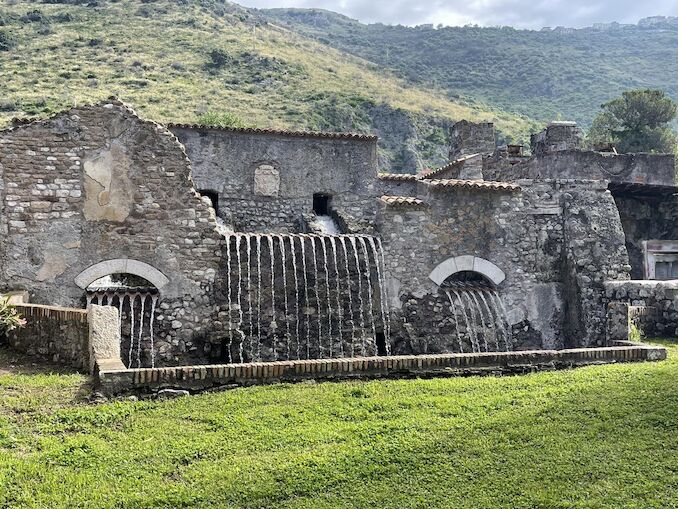
16 June 2023
The Garden of Ninfa
The Garden of Ninfa was founded in 1920 on the remains of an ancient medieval town. The history of this place, however, began in Roman times with a small temple dedicated to the deities of spring waters and was consolidated in the 8th century when the settlement became part of the papal administration and, later, of the estates of various noble families in the Lazio region.
The Caetani family became its owners around 1200 thanks to the support of Benedetto Caetani known as Pope Boniface VIII. The city became a very important center, especially on a commercial level. A power and wealth that brought it to the center of bitter clashes culminating, in 1382 with its destruction. The remains, which later became ruins, remained abandoned for centuries until, in the early 1900s, the Caetani family decided to return to their estates, aware that the enhancement of Ninfa's immense historical, environmental and cultural resources passed through the promotion of the site's natural beauty. At this time the Garden of Ninfa began to take shape.
The work began in 1920 with Gelasio Caetani, who, confronting his English mother, Ada Bootle Wilbraham, planted a large number of essences. As the Town Hall became the family's country home, he reorganized the water system and harnessed the power of the waters to create evocative waterways formed by the succession of ponds, waterfalls and streams that crept through the vegetation. When he passed away in 1934, the Garden was taken care of by his brother Roffredo, a musician and composer, and his wife Marguerite Chapin, an American and indefatigable patron of the arts, a literary scholar, journalist and art collector as well as editor of two important literary magazines, Commerce and Botteghe Oscure. Ninfa became, in those years, a cultural hub and a place of inspiration for some of the most important writers of the time. Just to name a few: Giorgio Bassani, Gabriele D'Annunzio, Alberto Moravia, Ignazio Silone, Pier Paolo Pasolini, Carlo Levi, Elsa Morante, Pietro Citati, Attilio Bertolucci among the Italians, and Boris Pasternak, Virginia Woolf, T. S. Eliot, Philippe Jaccottet, among foreigners. In 1950 Roffredo entrusted the garden to his daughter Lelia, whose pictorial talents and deep sensitivity to the world of nature he knew. The noblewoman created the garden of art, and her qualities as a painter enabled her to achieve striking color effects. The princess, before her passing, wanted to establish the Roffredo Caetani Foundation. An institution that bears her father's name and that has managed, for more than fifty years now, the assets of the noble family with the specific goal of protecting the memory of the Caetani House and preserving the Garden of Ninfa and the Caetani Castle in Sermoneta. Today the Garden of Ninfa hosts more than 1,500 plants from every corner of the world and is a Natural Monument of the Lazio Region.
The Caetani family became its owners around 1200 thanks to the support of Benedetto Caetani known as Pope Boniface VIII. The city became a very important center, especially on a commercial level. A power and wealth that brought it to the center of bitter clashes culminating, in 1382 with its destruction. The remains, which later became ruins, remained abandoned for centuries until, in the early 1900s, the Caetani family decided to return to their estates, aware that the enhancement of Ninfa's immense historical, environmental and cultural resources passed through the promotion of the site's natural beauty. At this time the Garden of Ninfa began to take shape.
The work began in 1920 with Gelasio Caetani, who, confronting his English mother, Ada Bootle Wilbraham, planted a large number of essences. As the Town Hall became the family's country home, he reorganized the water system and harnessed the power of the waters to create evocative waterways formed by the succession of ponds, waterfalls and streams that crept through the vegetation. When he passed away in 1934, the Garden was taken care of by his brother Roffredo, a musician and composer, and his wife Marguerite Chapin, an American and indefatigable patron of the arts, a literary scholar, journalist and art collector as well as editor of two important literary magazines, Commerce and Botteghe Oscure. Ninfa became, in those years, a cultural hub and a place of inspiration for some of the most important writers of the time. Just to name a few: Giorgio Bassani, Gabriele D'Annunzio, Alberto Moravia, Ignazio Silone, Pier Paolo Pasolini, Carlo Levi, Elsa Morante, Pietro Citati, Attilio Bertolucci among the Italians, and Boris Pasternak, Virginia Woolf, T. S. Eliot, Philippe Jaccottet, among foreigners. In 1950 Roffredo entrusted the garden to his daughter Lelia, whose pictorial talents and deep sensitivity to the world of nature he knew. The noblewoman created the garden of art, and her qualities as a painter enabled her to achieve striking color effects. The princess, before her passing, wanted to establish the Roffredo Caetani Foundation. An institution that bears her father's name and that has managed, for more than fifty years now, the assets of the noble family with the specific goal of protecting the memory of the Caetani House and preserving the Garden of Ninfa and the Caetani Castle in Sermoneta. Today the Garden of Ninfa hosts more than 1,500 plants from every corner of the world and is a Natural Monument of the Lazio Region.
The earth, the air, the land, and the water are not an inheritance from our forefathers but on loan from our children. So we have to handover to them at least as it was handed over to us.- Mahatma Gandhi - |






